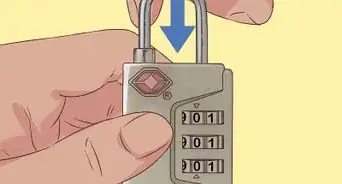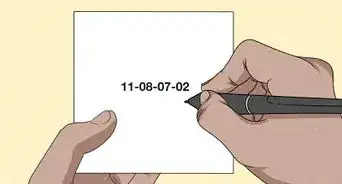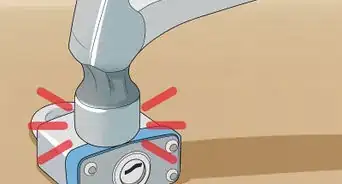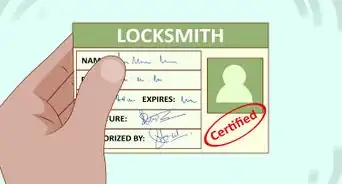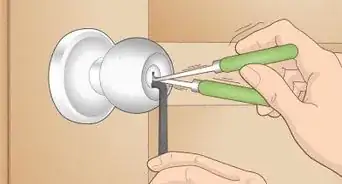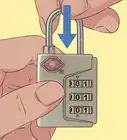X
This article was co-authored by Shawn Fago. Shawn Fago is a Master Locksmith and the Founder of Noble Locksmith, a nationwide locksmith company based in San Diego, California. With over seven years of experience, he provides commercial, residential, and automotive locksmith services to customers. Shawn attended California State University, Fullerton.
This article has been viewed 94,064 times.
Locks typically last for around seven years. To maximize the lifespan of your lock, you should perform regular cleaning and lubrication. You can use compressed air to clean locks, as well as wet cleaners like WD-40. Dry lubes are great for locks because they require less follow up lubrication.[1]
Steps
Method 1
Method 1 of 3:
Doing Routine Maintenance
-
1Blow dust out of the keyhole. Use a can of pressurized air or an air compressor to blow the dust out of the lock. Point the spray nozzle close to the keyhole and press down on the pressure button to blow air through the locking mechanism.[2]
-
2Spray the lock cylinder and opening. Use a spray cleaner, such as WD-40, to clean the lock cylinder and opening. Spray the cleaner into the keyhole.[3]Advertisement
-
3Lube the lock with a dry lubricant. In order to avoid the accumulation of dust inside the lock, you want to use a dry lubricant. Spray a dry lock lubricant, such as 3-in-one lock dry lube, into the keyhole. Insert your key and move it around to spread the lube into the lock.[4]
-
4Use WD-40 as a short term solution. If you are in a pinch and just need to get your lock moving quickly, you could try WD-40. Spray WD-40 into the keyhole. Insert your key into the keyhole and open and close the lock in order to work the WD-40 into the deadbolt.[5]
- Keep in mind that WD-40 will attract dust particles and eventually gum up your lock. It should only be used as a short-term solution.
Advertisement
Method 2
Method 2 of 3:
Tackling a Deep Cleaning Job
-
1Take apart the lock. Remove the screws holding the lock to the door. Unscrew the two screws underneath the door knob, as well as the screws holding the faceplate to the side of the door. Pull out the doorknob and the faceplate. Put all of the parts on a sheet of newspaper or cardboard so that you don’t lose track of anything.[6]
-
2Clean every part of the lock with WD-40. Use a spray cleaner or WD-40 to clean all of the parts of the lock. Wipe off any dirt or grime from the door knob, cylinder, faceplate and other parts. Get any remaining liquid cleaner or WD-40 off the lock.[7]
- If dirt or grime drips out of the lock, make sure you have a rag to catch any drips.
- Make sure you properly clean the keyhole and all moving parts.
-
3Apply graphite lubricant to all parts of the deadbolt. Make sure all of the parts of the lock are dry. Then, apply graphite lubricant to all parts of the lock. Squeeze some graphite into the keyhole, as well as onto the cylinder and other moving parts.[8]
- Graphite lubricant is less likely to require follow up lubrication.
-
4Put the lock back together. Put the latch-bolt and faceplate back on the side of the door. Put the outside door knob on. Then, put the inside door knob on. Put on the faceplate. Tighten all of the screws. Turn the door knob to make sure everything is turning smoothly. [9]
Advertisement
Method 3
Method 3 of 3:
Oiling a Night Latch and Padlock
-
1Grease the interior latch and switch. Add a few drops of oil to the interior latch of the night latch. Then, add a drop of oil to the snip switch and to the base of the knob.[10]
- A few drops of oil should also be applied to the sliding bolt.
-
2Lube the exterior of the night latch. Use a dry lubricant to lube the exterior of the night latch, which will avoid the accumulation of dust and grime in the locking mechanism. Puff a bit of graphite powder into the keyhole on the exterior of the night latch. Insert the key and turn it a few times, which will help distribute the graphite into the locking mechanism.[11]
-
3Lube a padlock. Puff some graphite lubricant into the keyhole on the padlock. Insert a key and move it around to spread the graphite throughout the cylinder. Then, apply some oil to the shackle and shackle hole on the padlock.[12]
Advertisement
Expert Q&A
-
QuestionIs it OK to put WD-40 in the car door lock?
 Shawn FagoShawn Fago is a Master Locksmith and the Founder of Noble Locksmith, a nationwide locksmith company based in San Diego, California. With over seven years of experience, he provides commercial, residential, and automotive locksmith services to customers. Shawn attended California State University, Fullerton.
Shawn FagoShawn Fago is a Master Locksmith and the Founder of Noble Locksmith, a nationwide locksmith company based in San Diego, California. With over seven years of experience, he provides commercial, residential, and automotive locksmith services to customers. Shawn attended California State University, Fullerton.
Master Locksmith Not really. WD-40 is a petroleum based product and will clean the lock in the short term, but it will start to collect dust and make it worse over time. There are specialized lubricants for locks, but you need to take the lock apart and grease the wafers. All that being said, lock lubricant is really not very necessary most of the time. If a lock is not turning properly, you typically have different issues such as a badly worn key or a lock that is failing with wafers that are either worn out or worn down, and those should be addressed by a locksmith.
Not really. WD-40 is a petroleum based product and will clean the lock in the short term, but it will start to collect dust and make it worse over time. There are specialized lubricants for locks, but you need to take the lock apart and grease the wafers. All that being said, lock lubricant is really not very necessary most of the time. If a lock is not turning properly, you typically have different issues such as a badly worn key or a lock that is failing with wafers that are either worn out or worn down, and those should be addressed by a locksmith. -
QuestionIs WD-40 good for stopping lock-picking?
 R2_d2000Top AnswererNo, lubricating a lock with WD-40 will not stop lock-picking. It may actually make it a little easier.
R2_d2000Top AnswererNo, lubricating a lock with WD-40 will not stop lock-picking. It may actually make it a little easier. -
QuestionWD-40 ended up in my eye, and I can't see anything from it. This happened 6 days ago; am I blind forever in one eye?
 R2_d2000Top AnswererYou should visit an eye doctor or the emergency room immediately; they should be able to help you.
R2_d2000Top AnswererYou should visit an eye doctor or the emergency room immediately; they should be able to help you.
Advertisement
Warnings
- WD-40 should not be used in excess or as a replacement for proper lubricant. It is great for cleaning but tends to accumulate dust if used excessively.⧼thumbs_response⧽
- If you clean your door lock, remember to keep track of all of the parts.⧼thumbs_response⧽
Advertisement
References
- ↑ https://www.angieslist.com/articles/6-keys-proper-door-lock-maintenance.htm
- ↑ http://www.aconcordcarpenter.com/clean-lubricate-locks.html
- ↑ http://www.aconcordcarpenter.com/clean-lubricate-locks.html
- ↑ http://www.aconcordcarpenter.com/clean-lubricate-locks.html
- ↑ https://removeandreplace.com/2015/12/03/door-lock-is-hard-to-unlock-with-key-how-to-clean-and-lubricate-it-yourself/
- ↑ https://removeandreplace.com/2015/12/03/door-lock-is-hard-to-unlock-with-key-how-to-clean-and-lubricate-it-yourself/
- ↑ https://removeandreplace.com/2015/12/03/door-lock-is-hard-to-unlock-with-key-how-to-clean-and-lubricate-it-yourself/
- ↑ https://removeandreplace.com/2015/12/03/door-lock-is-hard-to-unlock-with-key-how-to-clean-and-lubricate-it-yourself/
- ↑ http://www.oneprojectcloser.com/how-to-install-door-knob-deadbolt/
About This Article
Advertisement
